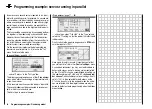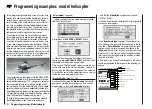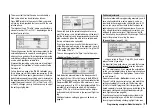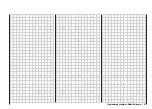
102
Example of MIX 1:
This completes the basic set-up for a typical F3A model.
Correcting model-specifi c errors
It is an unfortunate fact of life that even very careful-
ly built models exhibit minute faults and inaccuracies
which produce unwanted deviations when the model is
fl ying; the mixers of a computer radio control system are
then required to compensate for these defi ciencies. In
this section we will describe how to carry out the adjust-
ments required, but please note the following points be-
fore we get started: it is vital to ensure that the model is
built as accurately as humanly possible, is balanced per-
fectly around the lateral and longitudinal axes, and that
motor downthrust and sidethrust are set correctly.
1. Rudder causes unwanted movement around the
longitudinal and lateral axes
It is often the case that a rudder command cau-
ses the model to rotate slightly around the longitudi-
nal and / or lateral axis. This is particularly troubleso-
me in what is known as knife-edge fl ight, where the
model’s total lift is generated by the fuselage, aided
by the rudder defl ection. The result is that the mo-
del rotates and changes heading slightly, as if the pi-
lot were applying aileron or elevator at the same time.
These tendencies have to be corrected with compen-
sation around the lateral axis (elevator) and around
the longitudinal axis (aileron).
These corrections can be achieved easily with the
mx-16s, exploiting the »
free mixers
« once again.
For example, if the model rotates to the right around
the longitudinal (roll) axis when the rudder is defl ec-
ted, then a mixer is set up which defl ects the ailerons
slightly to the left. Heading changes around the late-
ral (elevator) axis can be corrected in a similar way
using a mixer acting upon the elevator:
a) Correction around the lateral axis (elevator)
MIX
„rd
el“
ASY
mmetrical setting. The exact values required
must be found by fl ight testing.
Programming examples: F3A model
b) Correction around the longitudinal axis (aileron)
MIX
„rd
ar“
ASY
mmetrical setting. The exact values required
must be found by fl ight testing.
In most cases relatively small mixer values are called
for, typically below 10%, but this does vary from mo-
del to model.
2. Vertical climb and descent
Many models exhibit a tendency to deviate from the
ideal line in vertical climbs and descents. To correct
this we need an elevator neutral position which varies
according to the throttle setting. For example, if the
model tends to pull out of a vertical descent by itself
when the motor is throttled back, slight down-elevator
must be mixed in at this throttle setting.
MIX
„c1
el“
As a rule you will need to set mixer values below 5%,
but once again there is no substitute for test-fl ying.
3. Rolling (movement around the longitudinal axis)
at idle
When you reduce the throttle setting, the model may
tend to roll slightly in one direction. Clearly an aile-
ron correction must be made. However, it is much
more elegant to let a mixer correct this effect for you
than to move the stick manually. Here again, a mixer
needs to be set up:
MIX
„c1
ar“
As a rule you will need to set mixer values below 5%,
but once again there is no substitute for test-fl ying.
The adjustment process should only be carried out
in calm weather. Often all you need to do is apply the
mixer in the control segment between half-throttle
and idle. To achieve this, leave the Offset point at the
centre position, and set up the mixer
ASY
metrically.
Содержание MX-16S
Страница 1: ...1...
Страница 17: ...17...
Страница 31: ...31 Fixed wing models Installation and connections...
Страница 35: ...35 Program description Reserving a new memory...
Страница 47: ...47 Base settings Model helicopter...
Страница 83: ...83 Fail safe...
Страница 89: ...89 Programming examples Fixed wing model...
Страница 109: ...109 Programming examples Model helicopter...
Страница 112: ...112 112...
Страница 116: ...116...















































